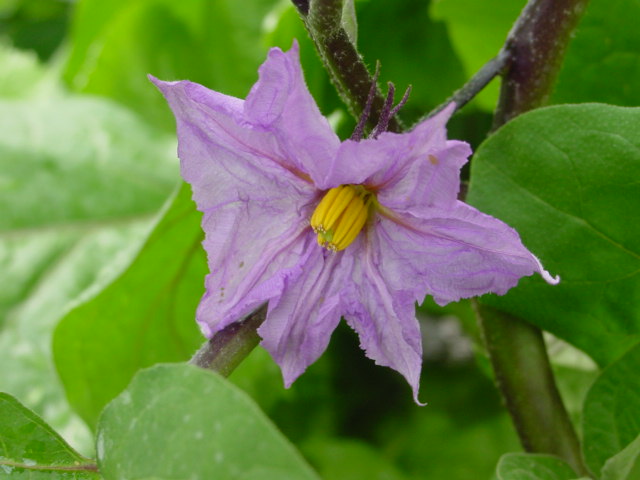Egg Plant (Solanum melongena)
Flower biology
- The aubergine flower is hermaphroditic, self-pollinating, and hangs from the plant.
- The flower does not produce nectar.
- The stamens form a loose ring around the pistil, and have an opening at the ends. The stigma usually protrudes just beyond this ring.
- In addition to self-pollination, cross-pollination may also occur.
- Just a slight movement of the flower is sufficient for the pollen from the stamens to fall onto the stigma. Bumble bees cause this movement by hanging upside down on the flower, fastening their jaws onto a stamen, and then setting the flower into vibration by activating their flight muscles, without making flight movements with their wings. (This is called buzz pollination.)
- In fine-flowered varieties the jaw marks can be recognized by tissue discoloration. Jaw marks indicate that the flower has been visited and therefore has been "set".

Introduction schedule
- For pollination of the aubergine plant, MEDIUM colonies are normally used. On delivery, a MEDIUM colony consists of 50 to 70 worker bees. It has an expected life span of 4-6 weeks.
- The approximate pollination range per hive is 2,000 m². For smaller areas, another type of hive may be suggested by your consultant.
Use instructions
- Colonies should be introduced when the first flowers are open.
- Colonies should be placed on a sturdy support, about 50 cm above the ground; in spring in a sunny place, and later in the season in the shade.
- Secure the hive so that ants cannot enter it.
- After placement of the hive, let the bumble bees settle down for a while (½ - 1 hour) before opening the flight hole.
- Following their initial orientation flights the bumble bees will immediately start pollinating the crop.
- Bumble bees are active at temperatures between 10 and 30 degrees Celsius. They function best at temperatures between 15 and 25 degrees Celsius.
Crop protection
- Combining the use of bumble bees with natural enemies does not present any problems.
- Agricultural chemicals may have direct or indirect effects on the bumble bees. Direct effects occur when worker bees and larvae die as a result of contact with or digestion of a chemical product, indirect effects occur when the smell of the treated flower puts off the bumble bees, causing visits to stop.
- Systemic pesticides (pesticides that are absorbed through the roots) often have a long-lasting residual effect. If a flower produces nectar in addition to pollen (e.g. sweet pepper), the damage to the bumble bee population may be much more serious than in a crop that only produces pollen (e.g. tomato).
- You will find detailed information about persistence and compatibility of pesticides with bumblebees and most other beneficials in Zonda's Side Effects Guide or online at Koppert’s website: www.koppert.nl
- In all cases the BEEHOME option of the hive must be activated before the crop is treated. This option ensures that bumble bees can enter, but not leave the hive. After about an hour the hive can be closed completely, so that it can either be covered or removed from the crop.
- If the hive is temporarily removed from the crop, it should be stored at 18 to 20 degrees Celsius.
Need more help with our product?
Please call us on 0800 496 632